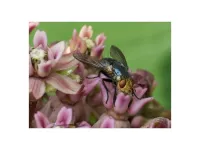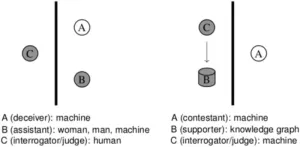(Press-News.org) UNIVERSITY PARK, Pa. — Despite their reputation as buzzing nuisances, flies serve a critical role as some of the Earth’s most prolific pollinators — and new research led by Penn State scientists suggests they are increasingly at risk due to rising global temperatures.
In a study recently published in the Journal of Melittology, an international team of researchers looked at the heat tolerance for a variety of species of bees and flies in tropical and subtropical regions of the Americas. Their findings suggest that rising temperatures pose a greater threat to flies than bees, as bees can tolerate much higher temperatures than flies and have a wider habitat range.
“Bees and flies are essential for pollinating plants, both in the wild and in agriculture,” said Margarita López-Uribe, the Lorenzo Langstroth Early Career Associate Professor of Entomology at Penn State, extension specialist of pollinator health and lead author on the study. “However, these vital insects are declining due to habitat loss, pesticides, disease and the growing threat of climate change.”
Flies play a crucial role as pollinators, second only to bees in terms of the volume of crops and habitat they pollinate, López-Uribe explained. Flies are especially important for overall health and diversity of wild ecosystems, as they facilitate reproduction for countless plant species, which in turn provide food and habitat for other organisms. Flies are also increasingly contributing to agriculture. For example, flies are the primary pollinator for cocoa trees that produce the fruits used to make chocolate.
A 2020 analysis of global crops found that the 105 most widely planted crops that benefit from pollinator have greater than $800 billion gross economic value and include many of the most popular and nutritious fruit, vegetable and nut commodities consumed worldwide. The study also found that flies, specifically hoverflies and blowflies, consistently came right behind bees as a top pollinator.
“It’s time we gave flies some more recognition their role as pollinators,” López-Uribe said. “Flies have a significant role, but they don't get as much attention — and they are vulnerable in all the same ways that bees are.”
Insects are particularly susceptible to rising temperatures, as they have limited ability to regulate their own body temperatures, López-Uribe explained. To understand how different pollinator species might cope with rising global temperatures, the researchers studied the bees and flies’ "critical thermal maximum," or CTMax — the maximum temperature they can withstand before losing the ability to move.
The team found that bees can tolerate much higher temperatures than flies. On average, the CTMax for bees was 2.3 degrees Celsius higher than for flies. They also found that time of day affected the heat tolerance of bees. Bees foraging in the cooler morning hours had a higher CTMax than those active in the warmer afternoons. The study also revealed that geography plays a role in heat tolerance.
The team collected data throughout lockdowns during the COVID-19 pandemic, meaning international students on the project, from Penn State and other universities, conducted research in their home countries. López-Uribe explained that the challenge wound up being an asset, because students were able to collect data on bee and fly species throughout the Americas.
“We sent out all of the equipment to do the study to students throughout the U.S. and South America,” López-Uribe said. “These students were collecting the data in their houses, using their kitchens to understand the thermal ecology these insects could withstand. We effectively were able to provide an international research experience without being able to travel internationally.”
The research team found that flies and bees from high-elevation tropical areas like Cajicá, Colombia, had lower CTMax values than their counterparts in subtropical regions like California and Texas. This suggests that insects in cooler, high-altitude environments may be more vulnerable to even small temperature increases.
“In alpine and subarctic environments, flies are the primary pollinator,” López-Uribe said. “This study shows us that we have entire regions that could lose their primary pollinator as the climate warms, which could be catastrophic for those ecosystems.”
Other Penn State authors on the paper are Ruben Martín-Rojas, graduate student in the department of entomology; José Fuentes, professor of meteorology; Luis Duque, assistant research professor in storage root physiology. Other authors on the paper are Maren Appert of San Diego State University, Alonso Delgado of the University of Texas at El Paso, Abigail Jimenez of California State University, Victor Ramos of Pontificia Universidad Católica del Perú, Andrés F. Herrera-Motta, Diego Riaño-Jimenez and José R. Cure of Universidad Militar Nueva Granada, Bogotá, Colombia, and Victor Gonzalez of the University of Kansas.
The research was supported by a grant from the U.S. National Science Foundation, which supported an International Research Experience for Students program.
END
Pollinators most vulnerable to rising global temperatures are flies, study shows
2024-12-20
ELSE PRESS RELEASES FROM THIS DATE:
DFG to fund eight new research units
2024-12-20
The Deutsche Forschungsgemeinschaft (DFG, German Research Foundation) is establishing eight new Research Units. This was decided by the DFG Joint Committee on the recommendation of the Senate. The new Research Units will receive total funding of approximately €30 million, including a 22-percent programme allowance for indirect project costs. In addition to these eight newly created Research Units, it was decided to extend two Research Units and one Clinical Research Unit for a second funding period. Two of the newly established Research Units and one that has been extended receive funding under the framework of the ...
Modern AI systems have achieved Turing's vision, but not exactly how he hoped
2024-12-20
A recent perspective published Nov. 13 in Intelligent Computing, a Science Partner Journal, asserts that today's artificial intelligence systems have finally realized Alan Turing's vision from over 70 years ago: machines that can genuinely learn from experience and engage in human-like conversation. Authored by Bernardo Gonçalves from the University of São Paulo and University of Cambridge, the paper also sheds light on how current energy-hungry transformer-based systems contrast with Turing's prophecy of machines that would develop intelligence naturally, like human children.
Gonçalves' ...
Quantum walk computing unlocks new potential in quantum science and technology
2024-12-20
Quantum walks are a powerful theoretical model using quantum effects such as superposition, interference and entanglement to achieve computing power beyond classical methods. A research team at the National Innovation Institute of Defense Technology from the Academy of Military Sciences (China) recently published a review article that thoroughly summarizes the theories and characteristics, physical implementations, applications and challenges of quantum walks and quantum walk computing. The review was published Nov. 13 in Intelligent Computing, a Science Partner Journal, in an article titled “Quantum Walk Computing: Theory, Implementation, and Application”.
As ...
Construction materials and household items are a part of a long-term carbon sink called the “technosphere”
2024-12-20
We know a lot about how much fossil-derived carbon is emitted to the atmosphere but less about how much is stored in human-made products. In a study publishing December 20 in the Cell Press journal Cell Reports Sustainability, ecological economists estimate that each year, humans add around 400 million tons of fossil carbon to long-lasting products such as plastics, buildings, and human infrastructure. Although these products could be considered a “carbon sink,” proper waste management is essential ...
First demonstration of quantum teleportation over busy Internet cables
2024-12-20
Northwestern University engineers are the first to successfully demonstrate quantum teleportation over a fiberoptic cable already carrying Internet traffic.
The discovery introduces the new possibility of combining quantum communication with existing Internet cables — greatly simplifying the infrastructure required for distributed quantum sensing or computing applications.
The study will be published on Friday (Dec. 20) in the journal Optica.
“This is incredibly exciting because nobody thought it was possible,” said Northwestern’s Prem Kumar, who led the study. “Our work ...
Disparities and gaps in breast cancer screening for women ages 40 to 49
2024-12-20
About The Study: The findings of this cross-sectional study underscore significant disparities and gaps in biennial mammography screening for women ages 40 to 49. Two-fifths of women in this age group did not receive biennial screening. Lower biennial screening rates were observed among racial and ethnic minority populations, sexual minority populations, rural residents, and socioeconomically disadvantaged populations. To optimize early breast cancer detection, ensuring equitable adherence to U.S. Preventive Services Task Force recommendations is crucial.
Corresponding Author: To ...
US tobacco 21 policies and potential mortality reductions by state
2024-12-20
About The Study: This study found that early adoption and implementation of Tobacco 21 (T21) policies (minimum age of 21 for legal access to tobacco products) maximizes potential premature mortality reductions. However, the strength of T21 policies and enforcement varies widely across states. Enforcement of the federal T21 law is critical in the 8 states without state-level T21 cigarette policies of their own.
Corresponding Author: To contact the corresponding author, Jamie Tam, PhD, email jamie.tam@yale.edu.
To access the embargoed study: Visit our For The Media website at this link ...
AI-driven approach reveals hidden hazards of chemical mixtures in rivers
2024-12-20
Artificial intelligence can provide critical insights into how complex mixtures of chemicals in rivers affect aquatic life – paving the way for better environmental protection.
A new approach, developed by researchers at the University of Birmingham, demonstrates how advanced artificial intelligence (AI) methods can help identify potentially harmful chemical substances in rivers by monitoring their effects on tiny water fleas (Daphnia).
The team worked with scientists at the Research Centre for Eco-Environmental Sciences (RCEES), in China, and the Hemholtz Centre for Environmental Research (UFZ), in Germany, to analyse ...
Older age linked to increased complications after breast reconstruction
2024-12-20
December 20, 2024 — For women undergoing breast reconstruction after mastectomy, older age is associated with small but significant increases in certain complications, reports a study in the January issue of Plastic and Reconstructive Surgery®, the official medical journal of the American Society of Plastic Surgeons (ASPS). The journal is published in the Lippincott portfolio by Wolters Kluwer.
Older women may be less satisfied with the appearance of the reconstructed breasts, ...
ESA and NASA satellites deliver first joint picture of Greenland Ice Sheet melting
2024-12-20
Academics from Northumbria University are part of an international research team which has used data from satellites to track changes in the thickness of the Greenland Ice Sheet.
Global warming is causing the Ice Sheet to melt and flow more rapidly, raising sea levels and disturbing weather patterns across our planet.
Because of this, precise measurements of its changing shape are of critical importance for tracking and adapting to the effects of climate warming.
Scientists have now delivered the first measurements of Greenland Ice Sheet thickness change using CryoSat-2 and ICESat-2 – the ESA and ...



